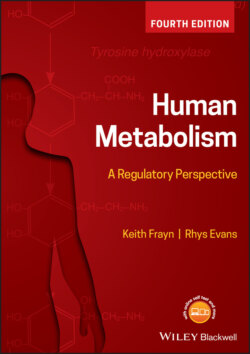Читать книгу Human Metabolism - Keith N. Frayn - Страница 44
Box 1.7 Fatty acid oxidation
ОглавлениеOnce a fatty acid enters the cell it is rapidly joined to Coenzyme A (CoASH) to form fatty acyl-CoA, by the enzyme ACS – it has been suggested that it may be linked with fatty acid transport into the cell so that the intracellular concentration of free fatty acids is kept very low. The fatty acyl-CoA may undergo esterification to triacylglycerol (for example, in adipose tissue) or it may be oxidised for energy release, by β-oxidation in the mitochondrion. However, long chain fatty acyl-CoA cannot cross the highly selective inner mitochondrial membrane (IMM), therefore the fatty acid is transported across on the carnitine shuttle. Carnitine is a highly charged molecule ((CH3)3N+CH2CH(OH)CH2COO−) and there is a specific translocase for it to move (with and without esterified acyl group) across the mitochondrial membranes. The carnitine shuttle is initiated by carnitine palmitoyl transferase-1 (CPT-1) on the outer mitochondrial membrane (OMM), which transfers the fatty acyl group from CoA to carnitine. This compound can cross the IMM in association with a translocase before being reconverted to fatty acyl-CoA by carnitine palmitoyl transferase-2 (CPT-2). CPT-1 is strongly inhibited by malonyl-CoA, the first intermediate of the ‘opposite’ pathway – lipogenesis – hence a reciprocal regulatory mechanism prevents fatty acid degradation (oxidation) and synthesis from occurring simultaneously, which would represent an inefficient futile cycle.
The fatty acyl-CoA that results in the mitochondrial matrix now undergoes β-oxidation. β-oxidation is so called because the β-carbon (second methyl carbon) of the FA chain is attacked, in a reaction sequence involving oxidation, hydration and thiolysis, releasing the 2-carbon acetyl group, again attached to CoA, all within mitochondria. The process is cyclically repeated until the entire FA chain has been broken down to acetyl-CoA 2 carbon units. β-oxidation occurs by a multienzyme trifunctional protein complex which catalyses an oxidative cycle generating acetyl-CoA, NADH and FADH2. The acetyl-CoA undergoes further oxidation to CO2 in the TCA cycle (also within the mitochondrial matrix), whilst the NADH and FADH2 (that derived both from oxidation of the acetyl-CoA by the TCA cycle and also that derived from β-oxidation itself) are then re-oxidised by the electron transport chain, yielding ATP. Each cycle of β-oxidation produces a theoretical maximum of 17 ATPs (though due to some inherent inefficiencies including some proton ‘leak’ across the IMM, in practice ∼14 ATP) – hence palmitate (16 carbons → 8 acetyl-CoA) yields a theoretical maximum of 106 ATP. Odd number carbon fatty acids (which are relatively rare) produce the 3-carbon propionyl-CoA in their final β-oxidation cycle; this can go on to produce succinyl-CoA, an intermediate of the TCA cycle, and hence an anaplerotic substrate – an example of lipids potentially producing carbohydrates, though limited by the relative rarity of these fatty acids.
Although most β-oxidation occurs in mitochondria, some fatty acid oxidation also takes place in organelles called peroxisomes. Peroxisomes seem to be particularly responsible for oxidation of fatty acids of relatively unusual (or at least, relatively rare) structure, especially very long chain fatty acids (22 or more carbons) and branched chain fatty acids, such as phytanic acid. Peroxisomal β-oxidation of very long chain fatty acids produces medium chain fatty acids which can then be further oxidised in mitochondria (at least in humans), but also produces hydrogen peroxide (H2O2), a reactive oxygen species which must be reduced. Very long- and branched chain fatty acids can only be metabolised in peroxisomes: congenital lack of peroxisomes, such as occurs in Zellweger syndrome and infantile Refsum’s disease, is associated with inability to oxidise these fatty acids and consequent hepatic and neurological dysfunction.
Whilst the above pathway predominates in muscle, supplying large amounts of ATP for biological work such as contraction, in liver acetyl-CoA derived from fatty acid β-oxidation is also used for ketone body synthesis (ketogenesis). Ketone bodies (acetoacetate, 3-hydroxybutyrate) are 4-carbon compounds and represent a soluble transport form of acetyl-CoA (effectively two acetyl-CoA’s joined together). This will be discussed further in Chapter 5. Acetoacetate undergoes spontaneous decarboxylation to the 3-carbon acetone: acetone probably has no physiological function in humans but is volatile and excreted in the breath with a characteristic sweet-smelling odour. (There is some evidence that acetone is converted into methylglyoxal and 1,2-propanediol, which can both act as gluconeogenic substrates, hence this is another [but also quantitatively minor] mechanism for converting lipids into carbohydrates.) Since brain cannot utilise fatty acids, the liver converts NEFAs to ketone bodies, which are exported to the brain (and other oxidative tissues such as muscle) where they are readily converted back into acetyl-CoA for oxidation in the TCA cycle and ATP production. Ketone bodies therefore constitute a major glucose-sparing fuel. Ketogenesis occurs exclusively in the liver; however, liver lacks the pathway for ketone body utilisation (ketolysis), preventing intracellular substrate cycling.
